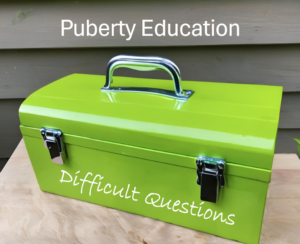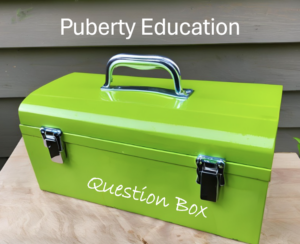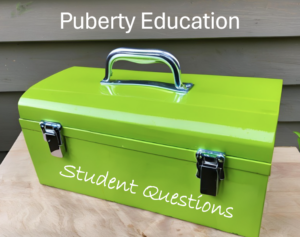This is the last in a series of six posts about engaging your students in puberty class. Read Part 1 HERE.
Strategy #6: Manage Behavior
Student engagement in puberty class increases when educators effectively manage behavior. Engaged students are less likely to act out in the classroom. Conversely, students who are acting out are less likely to be engaged. Managing behavior in the classroom is a crucial aspect of creating a positive and productive learning environment. It requires a thoughtful and proactive approach that focuses on building relationships, establishing routines, and rewarding positive choices. In this blog post, we will explore strategies and practical tools for effective behavior management which can develop a harmonious and engaging classroom atmosphere.
Build Relationships:
One of the principles of managing behavior is to build strong relationships with each scholar. Taking the time to understand their unique needs, interests, and challenges creates a foundation of trust and respect. When scholars feel valued and heard, they are more likely to exhibit positive behavior and actively participate in class. Regular check-ins, individual conferences, and creating opportunities for collaboration can foster a supportive teacher-student relationship. Research studies have shown that positive teacher-student relationships significantly contribute to improved behavior and academic performance [1].
Establish Predictable Routines:
Maintaining a predictable routine is a trauma-informed strategy that provides scholars with a sense of safety and stability. Consistency in daily schedules and clear expectations helps scholars feel secure and reduces anxiety, especially for those who may have experienced trauma. By outlining a structured routine, teachers can set a foundation for productive learning while minimizing disruptions caused by unexpected events. Trauma-informed classroom management strategies have been found to enhance scholar engagement and decrease challenging behaviors [2].
Teach and Reward Positive Behaviors:
Teaching, acknowledging, and reinforcing positive behavior is an effective way to encourage scholars to make good choices. Children need to be taught the desired prosocial behaviors; they don’t automatically come to school knowing the expectations. Positive Behavior Interventions and Supports (PBIS) and Social-Emotional Learning (SEL) programs are designed to teach students the behaviors they need to be successful at school. By providing specific praise and recognition of prosocial behaviors, teachers can motivate students to repeat positive actions. Utilizing tools like Behavior Bingo, where students earn stamps or tokens for demonstrating desired behaviors, can make the process more engaging and fun. These rewards can be redeemed for small prizes or privileges, creating a positive reinforcement loop that encourages continued positive behavior.
Ignore Negative Behavior:
Sometimes, students engage in negative behavior to seek attention or disrupt the class. In such instances, it can be helpful to use an ignoring strategy, where the teacher refrains from providing attention or reinforcement for unwanted behavior. By redirecting attention towards positive actions and rewarding appropriate behavior, students understand that negative behavior does not yield the desired outcome. However, it is essential to note that this strategy should be employed cautiously and selectively, considering the severity and impact of the behavior on the learning environment.
Assign Responsibilities to Attention-Seeking Students:
Students who consistently seek attention may benefit from being given a specific job or responsibility within the classroom. Providing them with a role that contributes to the smooth functioning of the class can redirect their energy and focus them on a productive task. Teach them how to do the assigned responsibility to increase their ability to succeed and get attention in a prosocial manner. This strategy not only engages the student positively but also fosters a sense of ownership and responsibility, leading to improved behavior and self-esteem.
Managing behavior in the classroom requires a multifaceted approach that prioritizes relationship-building, establishes predictable routines, rewards positive choices, and addresses attention-seeking behavior. By implementing these strategies consistently, teachers can create an environment where students feel supported, motivated, and actively engaged in their learning journey.
This is part 6 of a six-part series on Engaging Students in Puberty Class.
Resources:
- 5 Positive Reinforcement Activities to Use in the Classroom, Positive Psychology
- Acknowledgement System Snapshot, California Technical Assistance Center on Positive Behavioral Interventions and Supports
- Fundamentals of SEL, CASEL
- How can you prevent or replace attention-seeking behavior? Applied Behavior Analysis
- Positive Behavior Interventions and Supports (PBIS), Center on PBIS
- Promoting Prosocial Behaviors in the Classroom, Edutopia
- Prosocial Involvement as a Positive Youth Development Construct: A Conceptual Review, Scientifc World Journal
References:
[1] Hamre, B. K., & Pianta, R. C. (2001). Early teacher-child relationships and the trajectory of children’s school outcomes through eighth grade. Child development, 72(2), 625-638. https://www.jstor.org/stable/1131933
[2] Durlak, J. A., Weissberg, R. P., Dymnicki, A. B., Taylor, R. D., & Schellinger, K. B. (2011). The impact of enhancing students’ social and emotional learning: A meta-analysis of school-based universal interventions. Child development, 82(1), 405-432.



